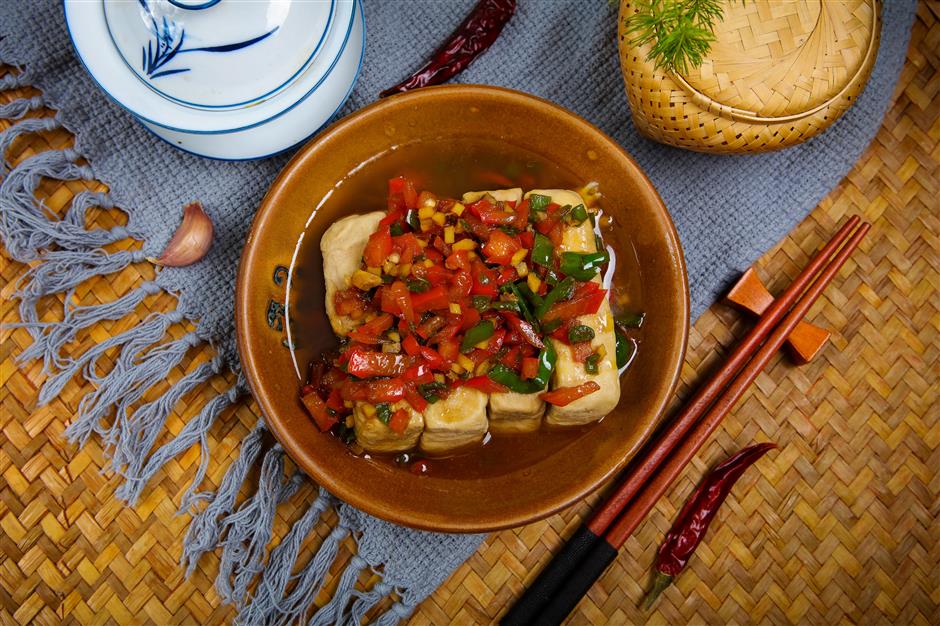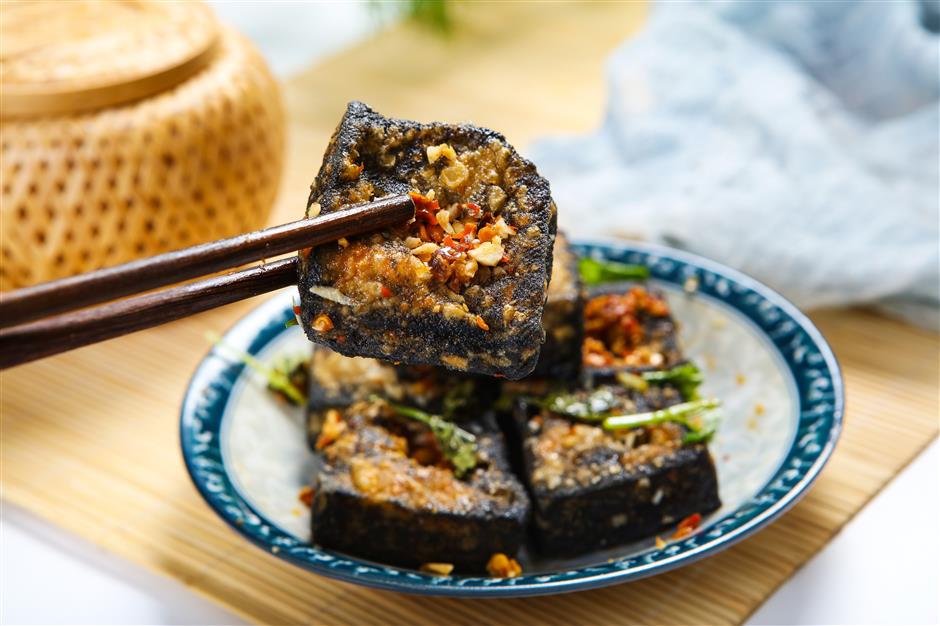Not for the faint of heart...or smell: stench to quench your taste buds
When it comes to stinky food, the unbearable, repulsive odor is actually the stepping stone to unlock great tastes.
There's always something about stinky food, as people are constantly propelled to be adventurous.
Those who have taken the first bites and grown to love the distinctly stinky delicacies would describe the experience with the folk saying, "smells bad but tastes good," and encourage others to be brave and simply give it a dry.
The rotten smell of stinky foods is usually produced in the making of the ingredients, such as fermentation or concealed storage. This week, we'll take a look at some of the iconic stinky delicacies in Chinese cuisine.

The smelly odor from stinky foods like stinky tofu and fish usually comes from the fermentation or brining process.
Stinky tofu
Stinky tofu is a staple in Chinese cuisine that can be served as a snack and a main course, and is a relatively easy stinky food for people unaccustomed to eating foods with strong odor to tolerate.
Across the country, Hunan-style stinky tofu is a crowd favorite snack at night markets, where it's served by small food trucks equipped with frying woks and bowls of toppings and condiments. With scorched black crust, the squares of stinky tofu are usually deep-fried to create a texture that's tender on the inside and crispy on the outside. The deep-frying process also tones down the stinky smell of the tofu, and flavorful small red chilies, minced garlic, cilantro and chili sauce toppings are generously added on top.
Black stinky tofu can also be incorporated into regular dishes. It can be braised, stir-fried with other ingredients and even steamed, then topped with chopped chilies for an intense combination of stinky and spicy flavors.

Fried stinky tofu with black crust
For people passionate about stinky food, Shaoxing, Zhejiang Province, is the perfect destination. Stinky tofu with yellow crust is a local staple that has also become popular nationwide. The stinky tofu is made with a particular brine seasoned with more than a dozen kinds of spices and herbs, and each stinky tofu maker has a unique secret recipe.
The tofu squares are brined and then deep-fried. It takes a couple of hours to soak the tofu in summer and over half a day in winter.
Deep-fried Shaoxing-style stinky tofu is made with a flavorful sauce consisting of chili and sesame sauces, garlic, cilantro, ginger and scallions.
It can also be steamed or braised with other ingredients, such as steamed fish, for enhanced flavor.
There's a notable stinky trio dish in Shaoxing – stinky tofu, stinky stalks of edible amaranth and stinky winter gourd (or another vegetable). The juice of the stinky edible amaranth stalks is also used to make other stinky delights. The stinky trio is not a dish for the faint hearted, because steam increases the stench of the ingredients.

Deep-fried Shaoxing-style stinky tofu
In Huaiyang cuisine, which is known for its fine knife work, delicate flavors and meticulous techniques, there's an iconic stinky dish called the "stinky duo of Jinling" – braised stinky tofu with pork intestines. This intensely flavored dish is popular in Nanjing. The most complicated step is actually cleaning and precooking the pork intestines, as the excess fat and residues must be removed.
Because both ingredients pack a malodorous punch, the stinky duo is heavily seasoned with chilies, garlic and soy sauce. Additional salt during braising usually isn't necessary, because the pre-cooked pork intestines and soy sauce provide sufficiently salty flavor. It's a great dish for the winter season when people are craving richer, more flavorful recipes.

Spicy braised stinky tofu with pork intestines
In Beijing, stinky fermented tofu known as qingfang is almost the Chinese equivalent of blue cheese, a high-protein spread with strong, smelly odors. It's one variety of traditional furu, but is eaten by fewer people than the red or white varieties because of its stinky smell.
The origin of qingfang is credited to Wang Zhihe in the Qing Dynasty (1644-1911). Its was an accident, as Wang once stored leftover tofu in a jar during a hot summer and only remembered it a few months later. When he opened the jar, the tofu cubes had a greenish hue, but the taste wasn't as bad as the smell.
On the contrary, the texture was creamy and smooth.
Wang's business expanded after he introduced qingfang, and it's said that Empress Dowager Cixi enjoyed the stinky delicacy.
Qingfang can be eaten as a condiment or a spread, usually on top of hot pancakes and steamed buns, as warmer temperatures melt some of it.

Qingfang, the soft yet very stinky furu.
Stinky fish
Stinky fish known as chouguiyu holds a unique place in Anhui cuisine, which is known for heavy, spicy and salty flavors.
Chouguiyu is usually made with freshwater Mandarin fish, and is a representative staple known for its peculiarly stinky smell and taste. It's said that about 200 years ago, fish mongers along the Yangtze River sold Mandarin fish around the region when winter arrived.
To prevent the fish from perishing, they sprinkled a layer of light salt water between two layers of fish and flipped it constantly. When the fish arrived in different destinations, it still had red gills, intact scales and the proper texture, but was usually accompanied by a special smell emanating from the skin that seemed stinky.
When the fish was rinsed and pan-fried with oil, not only did the stinky smell disappear, it also gave it a umami taste that made people wanting more. Traditional stinky fish is produced using natural fermentation, but today some restaurants use stinky furu to expedite the process and enhance the taste.
Today, stinky Mandarin fish is usually braised with bamboo shoots, chilies, pork, ginger, garlic and other ingredients.

Braised stinky fish is an iconic recipe in Anhui cuisine, made with freshwater Mandarin fish.
Stinky hotpot
The niubie hotpot of the Dong ethnic group in Guizhou Province is one of the more exotic and hardcore stinky dishes, which not only has a stinky odor but also an ingredient list that would make many people very hesitant.
The hotpot is made with the partially digested food found in a cow's largest stomach chamber, the rumen.
The cow is fed grass and herbs, the undigested food is removed and a green "juice" known as cow cud comes from squeezing the undigested food. The cow cud is then seasoned with herbs, spices and seasonings to make a hotpot broth.
People describe the smell of boiling niubie hotpot to be like cow dung, but locals in southeastern Guizhou are addicted to the uniquely bitter taste.
Changsha-style stinky tofu snack
Recreate the night market favorite in your kitchen.
Ingredients:
Raw stinky tofu squares, a dozen pieces
Garlic paste, 2 tablespoons
Chopped scallions, 2 tablespoons
Chopped cilantro, 2 tablespoons
Chili sauce, 1 tablespoon
Light soy sauce, 3 tablespoons
Steps:
1. The packaged raw stinky tofu can be found in supermarkets or online stores, and the black cubes should be thoroughly rinsed twice then soaked in clean water for a few hours.
2. Heat up a wok of enough oil to cover all the stinky tofu.
3. Estimate the oil temperature using a chopstick. The oil is ready when there are dense bubbles surrounding the chopstick. Over medium heat, deep-fry the stinky tofu for six to eight minutes. Remember to turn it constantly to ensure even cooking and a crispy crust.
4. In a bowl, mix the garlic paste, scallions, cilantro, chili sauce and light soy sauce to create a delicious dressing.
Serve the deep-fried stinky tofu sizzling hot with the dressing on top. You can also poke a hole in the center of the stinky tofu and put the dressing inside. It's a great snack to go with chilled beer.

Changsha-style stinky tofu with black crust and chili sauce
Braised pork intestines with stinky tofu
The stinky duo to warm up the body in winter, and a rice killer.
Ingredients:
Raw pork intestines, 400 grams
Stinky tofu, 10 pieces
Garlic, 6 cloves, minced
Ginger, 10 grams in slices, 10 grams in mince
Scallions, 4 sprigs
Dried chilies, 4
Star anise, 1
Bay leaf, 1
Light soy sauce, 1 tablespoon
Sugar, 1 teaspoon
White pepper and salt
Steps:
1. Thoroughly clean and rinse the pork intestines – it's important to remove all the excess fat – then boil in a pot of water with salt, ginger slices, star anise and a bay leaf. Spray the cooked pork intestines with cold water, then cut into smaller pieces. In the meantime, rinse and clean the stinky tofu.
2. Pan-fry the stinky tofu with oil until both sides are golden and crispy on the outside. In the same pan that still has some leftover oil, stir-fry the minced ginger and garlic, then toss in the pork intestines and season with light soy sauce and sugar.
3. Place the pan-fried stinky tofu and pork intestines in a clay pot, add some water and braise for several minutes with the lid on. When the dish is ready to serve, sprinkle it with chopped scallions for color and flavor.

 ?
?









